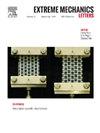压敏粘合剂的界面疲劳断裂
IF 4.3
3区 工程技术
Q2 MATERIALS SCIENCE, MULTIDISCIPLINARY
引用次数: 0
摘要
压敏胶(PSA)是一种粘弹性聚合物,可在指尖压力下与各种粘合剂形成快速而牢固的粘合。压敏胶的应用领域正在迅速扩大,如医疗保健、可穿戴电子设备和柔性显示器等,这就要求压敏胶在其整个使用寿命期间承受长时间的负载,从而要求对其疲劳行为进行基础研究。然而,对聚苯乙烯泡沫塑料疲劳的研究仍然很少。在此,我们研究了 PSA 的界面疲劳断裂,重点是 PSA 和粘合剂之间的非共价键逐渐断裂导致的周期性界面裂纹扩展。我们制作了一个模型 PSA,它由无滞后聚(丙烯酸丁酯)块状弹性体和粘弹性聚(丙烯酸丁酯-丙烯酸异冰片酯)粘性表面浸涂而成,两者均由聚(乙二醇)二丙烯酸酯交联。我们将制作好的 PSA 粘贴到聚酯条上,形成一个双层。双分子层由另一层聚酯薄膜覆盖,作为不可延伸的背层。通过循环和单调剥离试验,我们确定了双层膜的界面疲劳和断裂行为特征。根据实验数据,我们得到了循环剥离下的界面疲劳阈值(4.6 J/m2)、单调剥离下的慢速裂纹阈值(33.9 J/m2)以及有限剥离速度下的粘附韧性(∼ 400 J/m2)。我们建立了一个改进的 Lake-Thomas 模型来描述非共价键断裂导致的界面疲劳阈值。理论预测值(2.6 J/m2)与实验测量值(4.6 J/m2)非常吻合。最后,我们讨论了更大的慢速裂纹阈值和更大的粘附韧性可能涉及的其他耗散机制。希望本研究能为 PSAs 断裂力学提供新的基础知识,并为未来坚韧耐用的 PSAs 提供指导。本文章由计算机程序翻译,如有差异,请以英文原文为准。
Interfacial fatigue fracture of pressure sensitive adhesives
Pressure sensitive adhesives (PSAs) are viscoelastic polymers that can form fast and robust adhesion with various adherends under fingertip pressure. The rapidly expanding application domain of PSAs, such as healthcare, wearable electronics, and flexible displays, requires PSAs to sustain prolonged loads throughout their lifetime, calling for fundamental studies on their fatigue behaviors. However, fatigue of PSAs has remained poorly investigated. Here we study interfacial fatigue fracture of PSAs, focusing on the cyclic interfacial crack propagation due to the gradual rupture of noncovalent bonds between a PSA and an adherend. We fabricate a model PSA made of a hysteresis-free poly(butyl acrylate) bulk elastomer dip-coated with a viscoelastic poly(butyl acrylate-co-isobornyl acrylate) sticky surface, both crosslinked by poly(ethylene glycol) diacrylate. We adhere the fabricated PSA to a polyester strip to form a bilayer. The bilayer is covered by another polyester film as an inextensible backing layer. Using cyclic and monotonic peeling tests, we characterize the interfacial fatigue and fracture behaviors of the bilayer. From the experimental data, we obtain the interfacial fatigue threshold (4.6 J/m2) under cyclic peeling, the slow crack threshold (33.9 J/m2) under monotonic peeling, and the adhesion toughness (∼ 400 J/m2) at a finite peeling speed. We develop a modified Lake-Thomas model to describe the interfacial fatigue threshold due to noncovalent bond breaking. The theoretical prediction (2.6 J/m2) agrees well with the experimental measurement (4.6 J/m2). Finally, we discuss possible additional dissipation mechanisms involved in the larger slow crack threshold and much larger adhesion toughness. It is hoped that this study will provide new fundamental knowledge for fracture mechanics of PSAs, as well as guidance for future tough and durable PSAs.
求助全文
通过发布文献求助,成功后即可免费获取论文全文。
去求助
来源期刊

Extreme Mechanics Letters
Engineering-Mechanics of Materials
CiteScore
9.20
自引率
4.30%
发文量
179
审稿时长
45 days
期刊介绍:
Extreme Mechanics Letters (EML) enables rapid communication of research that highlights the role of mechanics in multi-disciplinary areas across materials science, physics, chemistry, biology, medicine and engineering. Emphasis is on the impact, depth and originality of new concepts, methods and observations at the forefront of applied sciences.
 求助内容:
求助内容: 应助结果提醒方式:
应助结果提醒方式:


